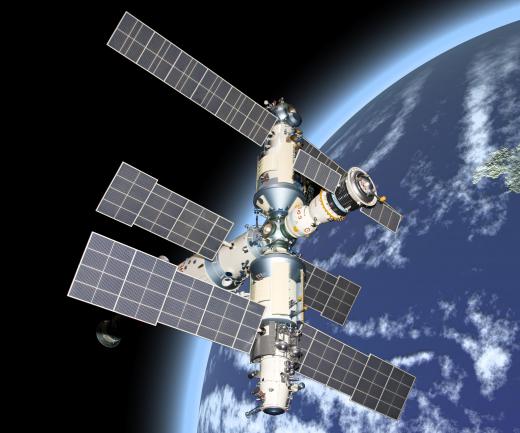What Is a Service Module?
 Mary McMahon
Mary McMahon
A service module is a unit in a spacecraft or space station that is entirely self-contained. The module may include avionics and equipment, propulsion systems, living quarters, and supply storage. Such units may be capable of launch and reentry to allow space agencies to reuse them, and can be configured in a variety of ways. Numerous nations have produced service modules for use on spacecraft and projects like the International Space Station (ISS).
Like other projects designed for deployment in space, a service module can be an expensive undertaking. Designers develop self-contained systems to protect the contents, including life support for service modules used to house personnel or projects that require astronauts to be inside, like science labs. It must be capable of enduring considerable force during launch, and in the case of equipment designed for reentry, it also needs to have systems to support a safe return to Earth.

On the International Space Station, service modules delivered by participating nations were used to build an orbiting research facility. The modular design allowed for the construction of a growing structure, rather than limiting the development to a single launch. Service modules added to the ISS may include features that allow them to be reconfigured in the future to accommodate new components. It is also possible to use them for different activities. A cargo bay, for example, might be converted into a lab if it has been designed for multiple configurations.
Inside a service module, there may be one or many compartments with different features. Some are designed entirely to carry cargo, and may be very large to accommodate big items. Others contain life support systems, propulsion, and controls, and fit with other modules to support a spacecraft or space station. In modules designed for astronauts, there may be command centers, living quarters, and facilities for eating, conducting experiments, and so forth.
Weight is an important consideration in service module design. Sending anything to space is extremely costly, and designers want to make sure that every pound counts. Excess weight in designs can be eliminated in a variety of ways, and the internal space may be designed for multipurpose uses and configurations to make it more useful. A service module with limited applications can be too expensive to launch and maintain, as the payoff from use may not balance out with the expense of designing, building, and launching it.
AS FEATURED ON:
AS FEATURED ON:











Discuss this Article
Post your comments